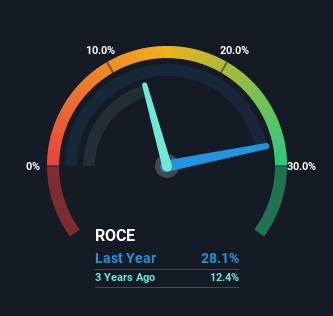- India
- /
- Metals and Mining
- /
- NSEI:TATASTEEL
Tata Steel (NSE:TATASTEEL) Is Achieving High Returns On Its Capital

If we want to find a potential multi-bagger, often there are underlying trends that can provide clues. One common approach is to try and find a company with returns on capital employed (ROCE) that are increasing, in conjunction with a growing amount of capital employed. If you see this, it typically means it's a company with a great business model and plenty of profitable reinvestment opportunities. Speaking of which, we noticed some great changes in Tata Steel's (NSE:TATASTEEL) returns on capital, so let's have a look.
What Is Return On Capital Employed (ROCE)?
Just to clarify if you're unsure, ROCE is a metric for evaluating how much pre-tax income (in percentage terms) a company earns on the capital invested in its business. Analysts use this formula to calculate it for Tata Steel:
Return on Capital Employed = Earnings Before Interest and Tax (EBIT) ÷ (Total Assets - Current Liabilities)
0.28 = ₹548b ÷ (₹2.9t - ₹906b) (Based on the trailing twelve months to June 2022).
Thus, Tata Steel has an ROCE of 28%. In absolute terms that's a great return and it's even better than the Metals and Mining industry average of 17%.
Check out our latest analysis for Tata Steel

In the above chart we have measured Tata Steel's prior ROCE against its prior performance, but the future is arguably more important. If you'd like, you can check out the forecasts from the analysts covering Tata Steel here for free.
How Are Returns Trending?
The trends we've noticed at Tata Steel are quite reassuring. Over the last five years, returns on capital employed have risen substantially to 28%. The amount of capital employed has increased too, by 58%. So we're very much inspired by what we're seeing at Tata Steel thanks to its ability to profitably reinvest capital.
What We Can Learn From Tata Steel's ROCE
In summary, it's great to see that Tata Steel can compound returns by consistently reinvesting capital at increasing rates of return, because these are some of the key ingredients of those highly sought after multi-baggers. Since the stock has returned a staggering 121% to shareholders over the last five years, it looks like investors are recognizing these changes. With that being said, we still think the promising fundamentals mean the company deserves some further due diligence.
One more thing: We've identified 3 warning signs with Tata Steel (at least 1 which is a bit unpleasant) , and understanding them would certainly be useful.
If you'd like to see other companies earning high returns, check out our free list of companies earning high returns with solid balance sheets here.
Valuation is complex, but we're here to simplify it.
Discover if Tata Steel might be undervalued or overvalued with our detailed analysis, featuring fair value estimates, potential risks, dividends, insider trades, and its financial condition.
Access Free AnalysisHave feedback on this article? Concerned about the content? Get in touch with us directly. Alternatively, email editorial-team (at) simplywallst.com.
This article by Simply Wall St is general in nature. We provide commentary based on historical data and analyst forecasts only using an unbiased methodology and our articles are not intended to be financial advice. It does not constitute a recommendation to buy or sell any stock, and does not take account of your objectives, or your financial situation. We aim to bring you long-term focused analysis driven by fundamental data. Note that our analysis may not factor in the latest price-sensitive company announcements or qualitative material. Simply Wall St has no position in any stocks mentioned.
About NSEI:TATASTEEL
Tata Steel
Engages in the manufacture and distribution of steel products in India and internationally.
Moderate growth potential second-rate dividend payer.


